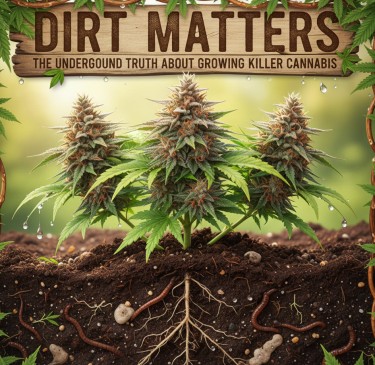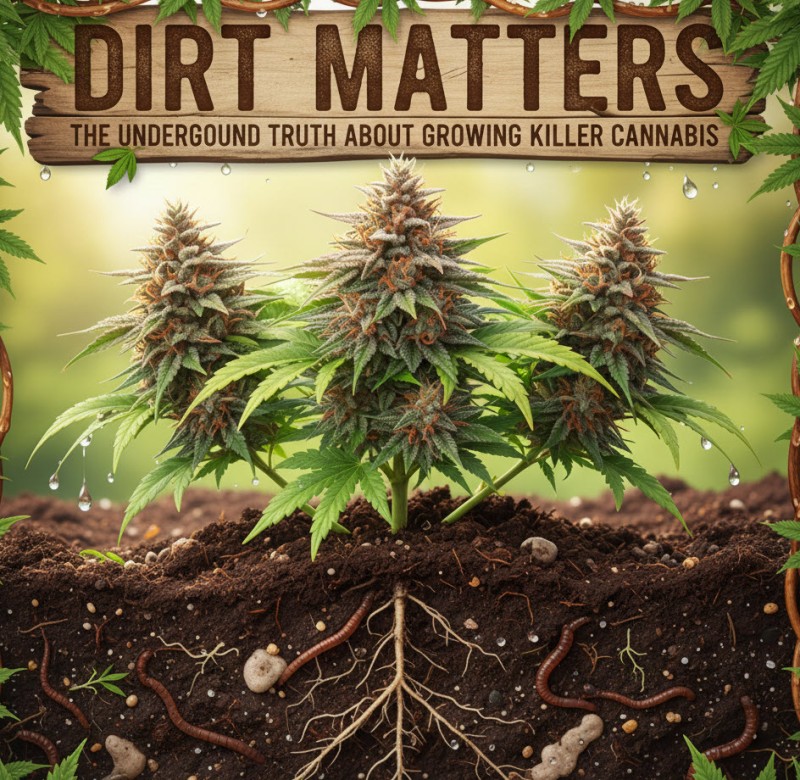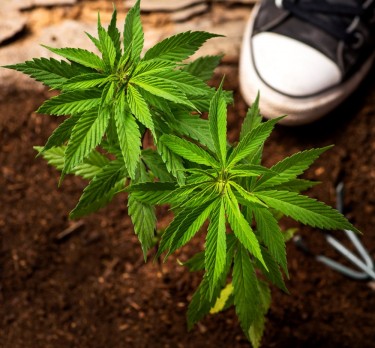
I've been growing cannabis long enough to have strong opinions about nearly everything—light spectrums, humidity levels, the superiority of organic nutrients over synthetic (fight me). But if you'd asked me five years ago whether the specific type of soil could fundamentally alter my THC levels, I would have nodded politely while internally rolling my eyes. Sure, soil affects plant health. Everyone knows that. But changing the actual chemical composition of cannabinoids? That seemed like grower mythology, the kind of thing passed around grow forums by people who also swear playing Mozart to their plants increases potency.
Well, I'm here to eat crow, admit I was wrong, and tell you that the dirt beneath your plants matters way more than most of us realized.
The USDA—yes, the United States Department of Agriculture—along with Penn State College of Medicine and Pennsylvania medical marijuana business PA Options for Wellness, just funded research that confirms what old-school organic growers have been whispering about for decades. Published in the Journal of Medicinally Active Plants, this study compared two hemp cultivars grown in neighboring fields: one using cover crops and no-till methods, the other using conventional tillage where you rip up the soil each season.
The results weren't subtle differences in yield or terpene profiles. We're talking about THC levels up to six times higher depending on soil type. Six times! That's the difference between a mild afternoon buzz and completely forgetting what decade you're in. Meanwhile, the healthier cover-cropped soil produced cannabigerol (CBG) levels 3.7 times higher than the depleted conventional fields.
This isn't just academic curiosity. This is actionable intelligence for anyone growing cannabis, whether you're running a licensed cultivation facility or tending a few plants in your backyard. Because if soil composition can swing cannabinoid production by factors of three, four, or even six, then understanding the relationship between what's happening underground and what ends up in your jar becomes essential knowledge. And here's the beautiful part: optimizing your soil doesn't require a chemistry degree or a massive budget. It requires understanding a few key principles about how cannabis plants respond to their environment at the root level.
The Science of Stressed-Out Plants: Why Bad Soil Makes Strong Weed
Here's the counterintuitive truth that this federally funded study reveals: cannabis plants grown in nutrient-depleted, biologically dead soil produced significantly higher THC levels than plants in rich, healthy soil. The conventionally tilled fields—where soil structure is destroyed annually, beneficial microbes are killed off, and organic matter is depleted—created plants pumping out THC at rates that would make any recreational grower drool.
But before you grab a shovel and start destroying your carefully cultivated living soil, let's understand why this happens, because the mechanism matters.
Cannabis produces cannabinoids and terpenes primarily as defense mechanisms. These compounds serve multiple purposes: they deter herbivores, protect against UV radiation, ward off pathogens, and help the plant compete with neighbors. When a cannabis plant finds itself in suboptimal conditions—poor soil, limited nutrients, biological stress—it goes into survival mode. It assumes the environment is hostile, so it cranks up production of its defensive compounds. THC is one of those compounds.
Think of it like this: a plant growing in rich, microbially diverse soil with perfect nutrient availability is like a trust fund kid at a country club. Life is good. Why produce excessive defensive compounds when everything is copacetic? But a plant struggling in depleted soil is like someone growing up in a rough neighborhood. You develop defenses. You get tough. You produce THC like your survival depends on it—because from the plant's perspective, it does.
The study showed this clearly. Cannabis grown in conventionally tilled soil had cannabidiolic acid (CBDA) levels over six times higher than cover-cropped plants for certain cultivars. But here's where it gets interesting: the healthier soil didn't just produce less THC. It produced significantly more of the precursor cannabinoid CBG—3.7 times more.
This suggests that soil health doesn't just affect how much cannabinoids a plant produces, but which cannabinoids dominate. CBG is the mother cannabinoid, the compound that gets converted into THC, CBD, and CBC through enzymatic processes. Plants in healthy soil were accumulating CBG rather than converting it all to THC. The researchers hypothesize this relates to enzyme production—specifically the enzymes responsible for converting CBG into other cannabinoids.
The soil isn't just a medium holding your plant upright. It's an ecosystem—a complex web of bacteria, fungi, archaea, protozoa, nematodes, and countless other organisms all communicating with your plant's roots through chemical signals. This communication network, sometimes called the "wood wide web," influences everything from nutrient uptake to pest resistance to, apparently, cannabinoid biosynthesis.
When you till soil conventionally, you destroy this network. You break fungal hyphae, expose microbes to UV light and air, and disrupt the soil structure that takes years to build. What you're left with is essentially dirt—mineral particles without the biological life that makes soil truly alive. And your cannabis plant, sensing this biological void, responds by entering defense mode and cranking up THC production.
Building Better Dirt: The Optimal Soil Profile for Cannabinoid Control
Now that we understand the mechanism, we can manipulate it. The question becomes: what do you want from your cannabis? Maximum THC? A balanced cannabinoid profile with high CBD and CBG? The ability to dial in specific ratios depending on your end use? Your soil strategy should match your goals.
For maximum THC production, the research suggests you actually want some degree of soil stress. But here's the nuance: you want controlled stress, not chaos. You're not trying to kill your plants; you're trying to make them work for it. A conventional grow using synthetic nutrients in a soilless medium accomplishes this. The plant gets what it needs to survive and produce, but it's not luxuriating in biological abundance. This is why hydroponic systems and coco coir often produce flowers with impressive THC percentages—the plants are essentially in controlled stress their entire lives.
But if you're interested in more complex cannabinoid profiles—particularly higher CBD or CBG—the research suggests you should focus on building genuine soil health. This means:
Organic Matter: Aim for 5-8% organic matter in your soil. This comes from compost, aged manure, cover crop residue, and leaf litter. Organic matter feeds the soil food web and provides slow-release nutrients.
Living Microbes: The soil microbiome is everything. Beneficial bacteria and fungi form symbiotic relationships with plant roots, trading nutrients for sugars. Mycorrhizal fungi are particularly crucial—they extend your plant's root system by orders of magnitude and help regulate nutrient uptake. You can inoculate with mycorrhizae, but they'll establish naturally in no-till systems.
Proper pH: Cannabis prefers slightly acidic soil, typically 6.0-7.0 pH. This range keeps nutrients available while supporting beneficial microbes. Test regularly and adjust with lime (to raise pH) or sulfur (to lower it).
Balanced Nutrients: The NPK ratio matters, but so do micronutrients. Cannabis is a nutrient-hungry plant, particularly during flowering. Healthy soil releases nutrients slowly through microbial activity rather than overwhelming the plant with synthetic salts.
Soil Structure: Good soil has aggregates—clumps of particles bound together by fungal hyphae and bacterial secretions. This creates pore spaces for air and water. You can't build structure by tilling; you build it by not tilling and by adding organic matter over time.
The no-till cover cropping method used in the study represents an advanced soil-building technique. You plant nitrogen-fixing legumes or other beneficial plants between growing seasons, then chop them down and leave them as mulch rather than tilling them in. Over time, this builds organic matter, feeds soil life, and creates increasingly complex biological systems.
But here's the practical application: if you want the highest THC, you might deliberately choose a less biologically rich medium. If you're targeting CBD or CBG for medical applications, invest in building your soil biology. You're essentially choosing between stressed plants that produce more defensive compounds versus healthy plants that produce more precursor cannabinoids.
The researchers noted that cultivar genetics still matter enormously. The Tangerine and CBD Stem Cell cultivars responded differently to soil types, with CBD levels moving in opposite directions depending on genetics. This means your variety selection and soil management must work together. Some genetics might perform better in stressed conditions; others might excel in rich soil.
The Sticky Bottom Line: Maximizing Your Soil on a Budget
Let's get practical. Not everyone can afford fancy amendments or has access to premium compost. Here's how to optimize your soil without breaking the bank:
Start with compost—but make it yourself. Kitchen scraps, yard waste, and even shredded paper become black gold with time and a little maintenance. Free compost beats expensive bottled nutrients every time because you're building biological systems, not just feeding plants.
Get cover crop seeds cheap. Crimson clover, hairy vetch, and winter rye cost dollars per pound. Plant them between grows or in adjoining beds. They fix nitrogen, suppress weeds, and die back into organic mulch you don't have to buy.
Stop tilling. Seriously. Every time you till, you set back your soil biology. Top-dress with compost and let worms incorporate it. Your back and your soil biome will thank you.
Find free organic matter. Tree services often give away wood chips. Coffee shops have spent grounds. Breweries have spent grain. Stables have aged manure. All become excellent amendments with minimal processing.
Make compost tea. Take finished compost, bubble it in dechlorinated water for 24-48 hours, and you've created a microbial inoculant that costs pennies per gallon. It's not magic, but it helps establish beneficial microbes.
The research proves that soil isn't just inert medium—it's a biological system that communicates with your plants and influences their chemistry at a fundamental level. Whether you're chasing maximum THC or building complex cannabinoid profiles, understanding this relationship gives you another tool in your growing arsenal. And the best part? The most effective soil-building techniques are often the cheapest. They just require patience, observation, and a willingness to work with biology rather than against it.
Your dirt matters. Treat it right, and it'll grow you exactly what you need.







